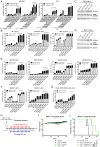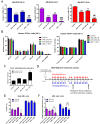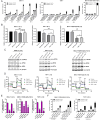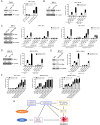ONC213: a novel strategy to resensitize resistant AML cells to venetoclax through induction of mitochondrial stress
- PMID: 39780285
- PMCID: PMC11714820
- DOI: 10.1186/s13046-024-03267-6
ONC213: a novel strategy to resensitize resistant AML cells to venetoclax through induction of mitochondrial stress
Abstract
Background: Venetoclax + azacitidine is a frontline treatment for older adult acute myeloid leukemia (AML) patients and a salvage therapy for relapsed/refractory patients who have been treated with intensive chemotherapy. While this is an important treatment option, many patients fail to achieve complete remission and of those that do, majority relapse. Leukemia stem cells (LSCs) are believed to be responsible for AML relapse and can be targeted through oxidative phosphorylation reduction. We previously reported that ONC213 disrupts oxidative phosphorylation and decreases Mcl-1 protein, which play a key role in venetoclax resistance. Here we investigated the antileukemic activity and underlying molecular mechanism of the combination of ONC213 + venetoclax against AML cells.
Methods: Flow cytometry was used to determine drug-induced apoptosis. Protein level changes were determined by western blot. An AML cell line-derived xenograft mouse model was used to determine the effects of ONC213 + venetoclax on survival. A patient-derived xenograft (PDX) mouse model was used to determine drug effects on CD45+/CD34+/CD38-/CD123 + cells. Colony formation assays were used to assess drug effects on AML progenitor cells. Mcl-1 and Bax/Bak knockdown and Mcl-1 overexpression were used to confirm their role in the mechanism of action. The effect of ONC213 + venetoclax on mitochondrial respiration was determined using a Seahorse bioanalyzer.
Results: ONC213 + venetoclax synergistically kills AML cells, including those resistant to venetoclax alone as well as venetoclax + azacitidine. The combination significantly reduced colony formation capacity of primary AML progenitors compared to the control and either treatment alone. Further, the combination prolonged survival in an AML cell line-derived xenograft model and significantly decreased LSCs in an AML PDX model.
Conclusions: ONC213 can resensitize VEN + AZA-resistant AML cells to venetoclax therapy and target LSCs ex vivo and in vivo.
Keywords: Acute myeloid leukemia; Azacitidine; ONC213; Venetoclax.
© 2024. The Author(s).
Conflict of interest statement
Declarations. Ethics approval and consent to participate: Diagnostic blast samples were obtained from the First Hospital of Jilin University. Written informed consent was provided, according to the Declaration of Helsinki. This study was approved by the Human Ethics Committee of The First Hospital of Jilin University (Ethical code # 2019 − 128). All animal experiments involving were approved by the Institutional Animal Care and Use Committee at Wayne State University. Consent for publication: Not applicable. Competing interests: ONC213 was provided by Chimerix, Inc., Durham, NC, 27713, and JEA and VVP are employees of Chimerix, Inc. The rest of the authors declare no competing financial interests.
Figures






Similar articles
-
(R)-WAC-224, a new anticancer quinolone, combined with venetoclax and azacitidine overcomes venetoclax-resistant AML through MCL-1 downregulation.Sci Rep. 2025 May 8;15(1):16018. doi: 10.1038/s41598-025-98534-7. Sci Rep. 2025. PMID: 40341200 Free PMC article.
-
Targeting the metabolic vulnerability of acute myeloid leukemia blasts with a combination of venetoclax and 8-chloro-adenosine.J Hematol Oncol. 2021 Apr 26;14(1):70. doi: 10.1186/s13045-021-01076-4. J Hematol Oncol. 2021. PMID: 33902674 Free PMC article.
-
225Ac-labeled CD33-targeting antibody reverses resistance to Bcl-2 inhibitor venetoclax in acute myeloid leukemia models.Cancer Med. 2021 Feb;10(3):1128-1140. doi: 10.1002/cam4.3665. Epub 2020 Dec 21. Cancer Med. 2021. PMID: 33347715 Free PMC article.
-
Relapse and resistance in acute myeloid leukemia post venetoclax: improving second lines therapy and combinations.Expert Rev Hematol. 2024 Oct;17(10):723-739. doi: 10.1080/17474086.2024.2402283. Epub 2024 Sep 13. Expert Rev Hematol. 2024. PMID: 39246164 Review.
-
Apoptosis targeted therapies in acute myeloid leukemia: an update.Expert Rev Hematol. 2020 Dec;13(12):1373-1386. doi: 10.1080/17474086.2020.1852923. Epub 2020 Dec 6. Expert Rev Hematol. 2020. PMID: 33205684 Review.
Cited by
-
Inhibition of the CXCR4/PLC Signaling Increases Dexamethasone-Induced Sensitivity by Activating the Mitochondrial Apoptotic Pathway in B-Cell Acute Lymphoblastic Leukemia.Int J Mol Sci. 2025 Apr 8;26(8):3489. doi: 10.3390/ijms26083489. Int J Mol Sci. 2025. PMID: 40331944 Free PMC article.
References
-
- SEER Cancer Stat Facts. Acute Myeloid Leukemia Bethesda, MD: National Cancer Institute; [Available from: https://seer.cancer.gov/statfacts/html/amyl.html]
-
- Bradbury DA, Zhu YM, Russell NH. Bcl-2 expression in acute myeloblastic leukaemia: relationship with autonomous growth and CD34 antigen expression. Leuk Lymphoma. 1997;24(3–4):221–8. - PubMed
-
- Delia D, Aiello A, Soligo D, Fontanella E, Melani C, Pezzella F, et al. bcl-2 proto-oncogene expression in normal and neoplastic human myeloid cells. Blood. 1992;79(5):1291–8. - PubMed
MeSH terms
Substances
Grants and funding
LinkOut - more resources
Full Text Sources
Medical
Research Materials
Miscellaneous

